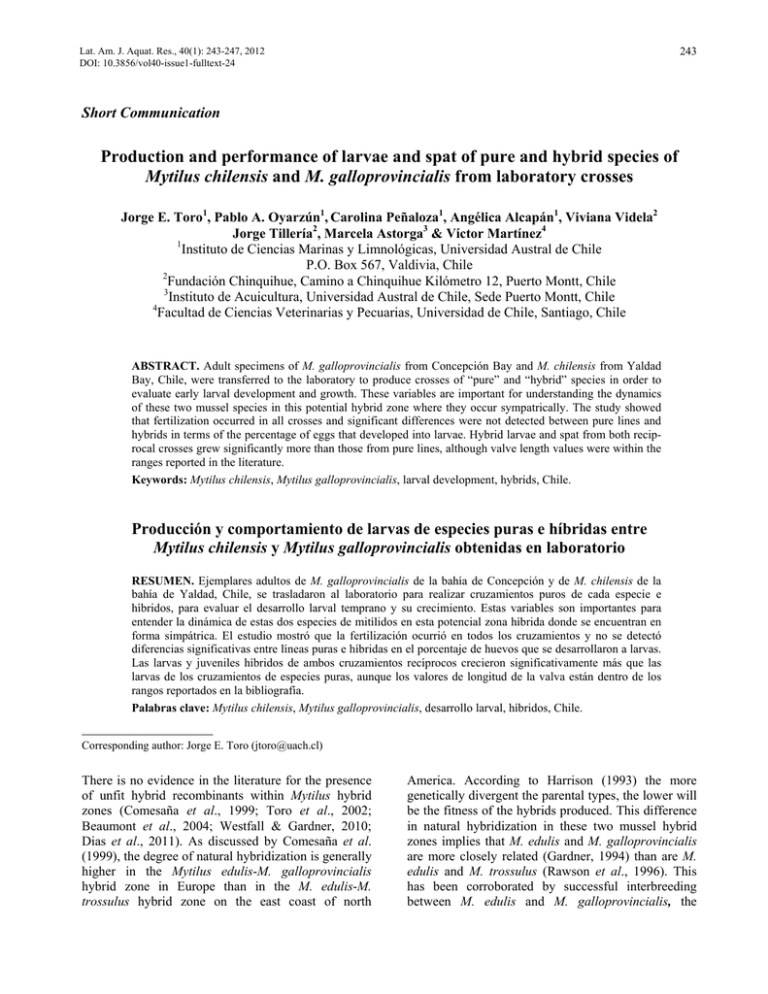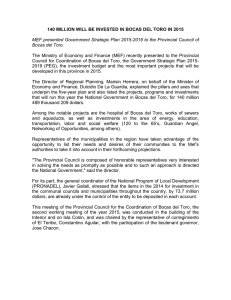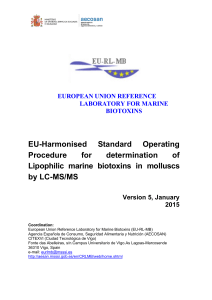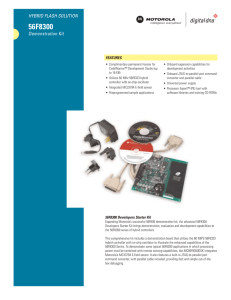Production and performance of larvae and spat of pure and
Anuncio

Lat. Am. J. Aquat. Res., 40(1): 243-247, 2012 DOI: 10.3856/vol40-issue1-fulltext-24 Mytilus hybrid larvae performance 243 Short Communication Production and performance of larvae and spat of pure and hybrid species of Mytilus chilensis and M. galloprovincialis from laboratory crosses Jorge E. Toro1, Pablo A. Oyarzún1, Carolina Peñaloza1, Angélica Alcapán1, Viviana Videla2 Jorge Tillería2, Marcela Astorga3 & Víctor Martínez4 1 Instituto de Ciencias Marinas y Limnológicas, Universidad Austral de Chile P.O. Box 567, Valdivia, Chile 2 Fundación Chinquihue, Camino a Chinquihue Kilómetro 12, Puerto Montt, Chile 3 Instituto de Acuicultura, Universidad Austral de Chile, Sede Puerto Montt, Chile 4 Facultad de Ciencias Veterinarias y Pecuarias, Universidad de Chile, Santiago, Chile ABSTRACT. Adult specimens of M. galloprovincialis from Concepción Bay and M. chilensis from Yaldad Bay, Chile, were transferred to the laboratory to produce crosses of “pure” and “hybrid” species in order to evaluate early larval development and growth. These variables are important for understanding the dynamics of these two mussel species in this potential hybrid zone where they occur sympatrically. The study showed that fertilization occurred in all crosses and significant differences were not detected between pure lines and hybrids in terms of the percentage of eggs that developed into larvae. Hybrid larvae and spat from both reciprocal crosses grew significantly more than those from pure lines, although valve length values were within the ranges reported in the literature. Keywords: Mytilus chilensis, Mytilus galloprovincialis, larval development, hybrids, Chile. Producción y comportamiento de larvas de especies puras e híbridas entre Mytilus chilensis y Mytilus galloprovincialis obtenidas en laboratorio RESUMEN. Ejemplares adultos de M. galloprovincialis de la bahía de Concepción y de M. chilensis de la bahía de Yaldad, Chile, se trasladaron al laboratorio para realizar cruzamientos puros de cada especie e híbridos, para evaluar el desarrollo larval temprano y su crecimiento. Estas variables son importantes para entender la dinámica de estas dos especies de mitílidos en esta potencial zona híbrida donde se encuentran en forma simpátrica. El estudio mostró que la fertilización ocurrió en todos los cruzamientos y no se detectó diferencias significativas entre líneas puras e híbridas en el porcentaje de huevos que se desarrollaron a larvas. Las larvas y juveniles híbridos de ambos cruzamientos recíprocos crecieron significativamente más que las larvas de los cruzamientos de especies puras, aunque los valores de longitud de la valva están dentro de los rangos reportados en la bibliografía. Palabras clave: Mytilus chilensis, Mytilus galloprovincialis, desarrollo larval, híbridos, Chile. ___________________ Corresponding author: Jorge E. Toro ([email protected]) There is no evidence in the literature for the presence of unfit hybrid recombinants within Mytilus hybrid zones (Comesaña et al., 1999; Toro et al., 2002; Beaumont et al., 2004; Westfall & Gardner, 2010; Dias et al., 2011). As discussed by Comesaña et al. (1999), the degree of natural hybridization is generally higher in the Mytilus edulis-M. galloprovincialis hybrid zone in Europe than in the M. edulis-M. trossulus hybrid zone on the east coast of north America. According to Harrison (1993) the more genetically divergent the parental types, the lower will be the fitness of the hybrids produced. This difference in natural hybridization in these two mussel hybrid zones implies that M. edulis and M. galloprovincialis are more closely related (Gardner, 1994) than are M. edulis and M. trossulus (Rawson et al., 1996). This has been corroborated by successful interbreeding between M. edulis and M. galloprovincialis, the 244 Latin American Journal of Aquatic Research production of viable offspring in back-crosses of F1 hybrids (Beaumont et al., 2004) and the suggestion made by Gardner (1994) that M. galloprovincialis may be a subspecies of M. edulis, proposing the use of the trinomial form M. edulis galloprovincialis. Mytilus chilensis is more closely related to Mytilus edulis than M. trossulus (Toro, 1998; Toro et al., 2005). The presence of natural beds of two species of mussels (Mytilus chilensis-M. galloprovincialis) in the central coast of Chile (Toro et al., 2005; Cárcamo et al., 2005; Tarifeño et al., 2005, Aldea & Valdovinos, 2005; Borsa et al., 2007; Ruiz et al., 2008) could represent a potential hybrid zone between the two species. There is, until now, no information on such variables on artificial hybridization between M. chilensis and M. galloprovincialis. The objective of the present study was to compare using controlled laboratory trials, the performance of pure lines and hybrids of M. chilensis and M. galloprovincialis during the crucial early stages of their development. Adult mussels (50-81 mm shell length) were collected from Caleta Tumbes (36°38`S, 72°57`W) at central coast of Chile (M. galloprovincialis) and from Yaldad (43°08`S, 73°44`W), southern Chile (M. chilensis) during November 2009 and held in ambient running seawater until required for spawning. Samples of adult mussels were collected from two geographically distant locations in order to avoid any possible inclusion of hybrids and introgressed individuals when the two mussels species are collected at locations were they are found sympatrically (Comesaña et al., 1999). Two hundred mussels were exposed to air for about 1 h, then placed in filtered seawater at ambient temperature, one mussel per beaker, for induction of spawning by thermal shock (20°C). In some cases, eggs and sperm were held for about 45 min at 18°C before use to allow as many mussels as possible to spawn, thereby helping to synchronize the egg stage (Scarpa & Allen, 1992). Eggs from each female were rinsed with filtered (1 µm) UV irradiated seawater (FSW) and then resuspended in 2000 mL FSW at 18°C for fertilization. Sperm concentration was determined with a hemocytometer. The sperm to egg ratio used for fertilization was approximately 100:1 in all trials (Toro et al., 2010). Eggs from each cross and each pure line were rinsed after 10 min to remove excess sperm and resuspended in 9-L glass flasks containing 7000 mL at a density 70-120 eggs mL-1 (Ruiz et al., 2008; Toro et al., 2008). The spawning and crosses were carried out using a factorial design, to allow full reciprocal crosses by using individual males and females from each species (pure and reciprocal crosses). Veliger larvae were reared at 18°C and 28-33 psu in 200-L glass-fiber tanks, using standard techniques (Toro et al., 2008). Sea water was filtered, sterilized with UV light and changed every other day. At each seawater change, the contents of each tank were passed separately through a 44 µm Nitex screen (empty tanks were treated with a low bleach concentration solution and then rinsed with FSW). Larvae retained on the screen were rinsed with treated seawater and back-washed into the cleaned tanks, which were then re-filled with filtered seawater. At each water change, larvae were fed Isochrysis galbana at 25.000-30000 cells mL-1 (Toro et al., 2008). The number of living larvae in the cultures was monitored before addition of food, and the volume of the water used in each culture was adjusted in order to maintain a density close to 8-10 larvae mL-1. On the 9 and the 16 day after fertilization, the percentage of live veliger larvae in each culture (the mean of 4 counts) was estimated within one field of view under the microscope at 100x magnification. The mean shell length of veliger larvae on the 9 and 16 day was estimated by measuring 30 randomly chosen larvae from each culture with image analyzer software. Heterosis, the improved performance of hybrids offspring compared to the average of their purespecies parents was estimated according to Falconer (1989) as H = average PF1 – average PPPP/ PPPP x 100, where PF1 is the average performance of hybrids and PP is the average performance of parent lines (Mallet, 1989). Larval shell length data at day 9 and 16 and from the spat at day 164, were tested by analysis of variance using the statistical software SPSS v 15.0.1 and Statistica v. 7.0. Fertilization occurred in all crosses and cleavage was observed within 30 to 40 min following mixing of eggs and sperm. No significant differences between pure lines and hybrids were detected in the percentage of eggs developed into larvae (P > 0.05). However, a few abnormal larvae were detected by direct observation in the hybrid crosses, but the proportion of normal veligers during the early stages of growth showed no significant differences between pure and hybrid crosses. Heterosis were detected at the larval stage at day 9 (3.0%) and day 16 (1.0%) and also at the spat stage for shell length (58.0%) and live weight (300%). Significant differences (P < 0.05) were detected between pure lines and hybrids for the shell length (maximum larval shell length) of veliger larvae (Table 1). Hybrid larvae from both reciprocal crosses grew significantly faster than larvae from pure lines (Table 1), although the shell length values are within the range of those reported for pure M. chilensis in trials carried out by Toro et al. (2008) and trials under Mytilus hybrid larvae performance 245 Table 1. Median of larval shell length (in parentheses the percentile 25-75%), for the hybridization between Mytilus chilensis (Mc)-M. galloprovincialis (Mg) and controls (pure species crosses), at 9 and 16 days post-fecundation. Summary of the ANOVA by Kruskal-Wallis ranges and results of multiple comparison Dunn test (values with same letters are not significant different P > 0.05). Tabla 1. Mediana del largo larval (entre paréntesis los percentiles 25-75%) para la hibridación entre Mytilus chilensis (Mc)-M. galloprovincialis (Mg) y los controles (cruces de especies puras), a los 9 y 16 días post-fecundación. Resumen del ANDEVA por rangos de Kruskal-Wallis y del resultado de la prueba de comparaciones múltiples de Dunn (Valores con la misma letra no son estadísticamente distintos P > 0,05). Day Crosses ♀Mg x ♂Mc ♀Mc x ♂Mc 9d ♀Mc x ♂Mg ♀Mg x ♂Mg N 90 88 100 113 Average (µm) H P Dunn 132.5 (127.5-135) 214.53 < 0.000 A 127.5 (125-130) B 125.0 (120-126.9) B 122,5 (120-125) C ♀Mg x ♂Mc 47 150 (145-157.5) 184.04 < 0.000 A ♀Mc x ♂Mc 111 135 (130-137.5) B 16 d ♀Mg x ♂Mg 11 132 (127.5-132.5) B ♀Mc x ♂Mg 3 120 (115-) C different feeding regimes undertaken by Toro & Paredes (1996). There was, however, a significant difference in growth between hybrid larvae of the two reciprocal crosses, the M. chilensis (female) crossed with M. galloprovincialis (male) hybrids being the lower growing larvae (Table 1). Juveniles from these crosses were evaluated for their shell length and total wet weight at day 164 after fertilization, showing significant differences between pure species crosses and their hybrids (Table 2). Because of the significantly bigger size reached by hybrid larvae and their spat (5 month old), compared with pure lines of M. chilensis and M. galloprovincilis, a positive heterosis was established, although it is not clear, at this stage, what advantages this may impart. Similar results have been reported by Beaumont et al. (2004) for crosses between M. edulis and M. galloprovincialis and by Freeman et al. (1994) for crosses between M. edulis and M. trossulus. Growth of bivalves seems to be related to the genetic conformation of the individual (Meyer & Manahan, 2010). High levels of homozygosity due to inbreeding can significantly reduce growth rate (Beaumont & Abdul-Martin, 1994) and, conversely, high degrees of heterozygosity (Bayne, 1999; Crnokrak & Barrett; 2002; Pace et al., 2006) may enhance growth rate. Hybridization should increase the heterozygosity of individuals, which may in part explain the higher growth observed in hybrid larval cultures in the present study. Reports of naturally occurring hybrids in several mussel hybrid zones (San Juan et al., 1994; Saavedra et al., 1996; Comesaña et al., 1999; Toro et al., 2005; Westfall & Gardner, 2010; Dias et al., 2011), and the data reported here all, confirm that these two species (M. chilensis and M. galloprovincialis) are interfertile. In fact, there was no significant difference between pure lines and hybrids in the percentage of eggs which developed into larvae (P > 0.05). Also, at the larvae stage, hybrid crosses showed no significant mortality than pure lines crosses (P > 0.05). The slight lower survivorship (not significant) may reflect subtle differences in the time of sexual maturity or gamete quality in the two species, and one explanation, according to the results obtained by Toro et al. (2002), may be that they have different optimum spawning times. The reproductive cycle of these mussel species found simpatrically in central Chile is currently being studied. A lower survivorship in F1 hybrid individuals found in other hybrid zones could also be due to the incompatibility between mitochondrial and nuclear genomes, which seems to be greater between M. trossulus and M. edulis than between M. edulis and M. galloprovincialis (Comesaña et al., 1999). Comesaña et al. (1999) clearly show that naturally occurring hybrids consist mostly of backcrosses. In a hybrid zone a slight overlap of spawning times, or a few individuals of either species or just very few F1 hybrids spawning with the other, would explain the existence of naturally occurring hybrids and the presence of backcrosses. The results of Comesaña et al. (1999) and Toro et al. (2004) suggest that hybridization between M. edulis and M. trossulus is not very common compared with that between M. edulis and M. galloprovincialis in Europe. Because the closely related species M. edulis with M. chilensis 246 Latin American Journal of Aquatic Research Table 2. Mean of shell length (in parentheses the standard deviation) for the hybridization between Mytilus chilensis (Mc)-M. galloprovincialis (Mg) and controls (pure species crosses) at 164 days post-fecundation. Summary of ANOVA and results of the Tukey test. Tabla 2. Promedio del largo valvar (entre paréntesis la desviación estándar) para las hibridaciones entre Mytilus chilensis (Mc)-Mytilus galloprovincialis (Mg) y los controles (cruzamiento de especies puras) a los 164 días post-fecundación. Resumen del ANDEVA y los resultados de la prueba de Tukey. Variable ANOVA P Crosses N Average Shell length (mm) ♀Mg x ♂Mc ♀Mc x ♂Mg ♀Mg x ♂Mg ♀Mc x ♂Mc 48 55 100 51 20.58 (2.52) 16.75 (4.32) 11.91 (2.26) 11.57 (2.6) 117.1 < 0.000 ♀Mg x ♂Mc ♀Mc x ♂Mg ♀Mc x ♂Mc ♀Mg x ♂Mg 48 55 51 100 0.91 (0.31) 0.54 (0.39) 0.20 (0.15) 0.16 (0.14) 113.9 < 0.000 Weight (g) (Koehn, 1991), we expected that a potentially chilean mussel hybrid zone could be represented by very high percentages of natural hybrids. The results of the present study provide evidence that there are no differences in the percentage of fertilized eggs between pure line crosses and hybrid crosses between M. chilensis and M. galloprovincialis. These observations suggest that there is little or no evidence of physiological barriers to fertilization, but that incompatibilities between mitochondrial and nuclear genomes may be causing some abnormalities among F1 hybrid larvae (Rawson et al., 1996; Quesada et al., 1998). Further research is required, including the study of pure line and reciprocal crosses, to assess the relative fitness of larval and juvenile hybrid mussels under different environmental conditions. ACKNOWLEDGMENTS This study was supported by grant FONDECYT 1095061. REFERENCES Aldea, C. & C. Valdovinos. 2005. Moluscos del intermareal rocoso del centro-sur de Chile (36°38°S): taxonomía y clave de identificación. Gayana, 69: 364-396. Bayne, B.L. 1999. Physiological components of growth differences between individual oysters (Crassostrea gigas) and a comparison with Saccostrea commercialis. Physiol. Biochem. Zool., 72: 705-713. F Tukey A B C C A B C C Beaumont, A.R., G. Turner, A.R. Wood & D.O. Skibinski. 2004. Hybridizations between Mytilus edulis and Mytilus galloprovincialis and performance of pure species and hybrid veliger larvae at different temperatures. J. Exp. Mar. Biol. Ecol., 302: 177-188. Beaumont, A.R. & A.K.M. Abdul-Martin. 1994. Differences in morphology, survival and size between self and cross-fertilized larvae of Mytilus galloprovincialis. J. Mar. Biol. Assoc. UK, 74: 445-448. Borsa, P., C. Daguin & N. Bierne. 2007. Genomic reticulation indicates mixed ancestry in southern hemisphere Mytilus spp. mussels. Biol. J. Linn Soc., 92: 747-754. Carcamo, C., A.S. Comesaña, F.M. Winkler & A. Sanjuan. 2005. Allozyme identification of mussels (Bivalvia: Mytilus) on the Pacific coast of South America. J. Shellfish Res., 24: 1101-1115. Comesaña, A.S., J.E. Toro, D.J. Innes & R.J. Thompson. 1999. A molecular approach to the ecology of a mussel (Mytilus edulis-M. trossulus) hybrid zone on the east coast of Newfoundland, Canada. Mar. Biol., 133: 213-221. Crnokrak, P. & S.C.H. Barrett. 2002. Perspective: purging the genetic load: a review of the experimental evidence. Evolution, 56: 2347-2358. Dias, P.J., B. Malgrange, M. Snow & I.M. Davies. 2011. Performance of mussels, Mytilus edulis, Mytilus trossulus, and their hybrids in cultivation at three Scottish Lochs. J. World Aquacult. Soc., 42: 111121. Falconer, D.S. 1981. Introduction to quantitative genetics. Longman Group Limited, London, 340 pp. Mytilus hybrid larvae performance Freeman, K.R., K.L. Perry, T.G. DiBacco & D.J. Scarratt. 1994. Observations on two mytilid species from a Nova Scotian mussel farm. Can. Tech. Rep. Fish. Aquat. Sci., 1969: 1-47. Gardner, J.P.A. 1994. The structure and dynamics of naturally occurring hybrid Mytilus edulis Linnaeus, 1758 and Mytilus galloprovincialis Lamarck, 1819 (Bivalvia: Mollusca) populations: review and interpretation. Arch. Hydrobiol. Suppl., 99: 37-71. Harrison, R.G. 1993. Hybrids and hybrid zones: historical perspective. In: R.G. Harrison (ed.). Hybrid zones and evolutionary process. Oxford University Press, Oxford, pp. 3-13. Koehn, R.K. 1991. The genetics and taxonomy of species in the genus Mytilus. Aquaculture, 94: 125-145. Mallet, A.L. 1982. Quantitative genetics of the Atlantic Canadian oyster, Crassostrea virginica (Gmelin). Ph.D. Thesis, Biology Department, Dalhousie University, Halifax, Nova Scotia, 150 pp. Meyer, E. & D.T. Manahan. 2010. Gene expression profiling of genetically determined growth variation in bivalve larvae. J. Exp. Biol., 213: 749-758. Pace, D.A., A.G. Marsh, P.K. Leong, A.J. Green, D. Hedgecock & D.T. Manahan. 2006. Physiological bases of genetically determined variation in growth of marine invertebrate larvae: a study of growth heterosis in the bivalve Crassostrea gigas. J. Exp. Mar. Biol. Ecol., 335: 188-209. Quesada, H., C. Gallagher, D.O.F. Skibinski & D.A.G. Skibinski. 1998. Patterns of polymorphism and gene flow of gender-associated mitochondrial DNA lineages in European mussel populations. Mol. Ecol., 7: 1041-1051. Rawson, P.D., C.L. Secor & T.J. Hilbish. 1996. The effects of natural hybridization on the regulation of doubly uniparental mtDNA inheritance in blue mussels (Mytilus spp.). Genetics, 144: 241-248. Ruiz, M., E. Tarifeño, A. Llanos-Rivera, C. Padget & B. Campos. 2008. Temperature effect in the embryonic and larval development of the mussel, Mytilus galloprovincialis (Lamarck, 1819). Rev. Biol. Mar. Oceanogr., 43: 51-62. Saavedra, C., D.T. Stewart, R.R. Stanwood & E. Zouros. 1996. Species-specific segregation of genderassociated mitochondrial DNA types in an area where two mussel species (Mytilus edulis and M. trossulus) hybridize. Genetics, 143: 1359-1367. Received: 29 April 2011; Accepted: 13 January 2012 247 Sanjuan, A., C. Zapata & G. Alvarez. 1994. Mytilus galloprovincialis and M. edulis on the coasts of the Iberian peninsula. Mar. Ecol. Prog. Ser., 113: 131146. Scarpa, J. & S.K. Allen Jr. 1992. Comparative kinetics of meiosis in hybrid crosses of Pacific oyster Crassostrea gigas and Suminoe oyster C. rivularis with the American oyster C. virginica. J. Exp. Zool., 263: 316-322. Toro, J.E. & L. Paredes. 1996. Heritability estimates of larval shell length in the Chilean mussel Mytilus chilensis Hupé, under different food densities. Aquat. Living Resour., 9: 347-350. Toro, J.E. 1998. PCR-based nuclear and mtDNA markers and shell morphology as an approach to study the taxonomic status of the Chilean blue mussel (Mytilus chilensis) (Bivalvia). Aquat. Living Resour., 11: 347353. Toro, J.E., R.J. Thompson & D.J. Innes. 2002. Reproductive isolation and reproductive output in two sympatric mussels species (Mytilus edulis, M. trossulus) and their hybrids from Newfoundland. Mar. Biol., 141: 897-909. Toro, J.E., D.J. Innes & R.J. Thompson. 2004. Genetic variation among life-history stages of mussels in a Mytilus edulis-M. trossulus hybrid zone. Mar. Biol., 145: 713-725. Toro, J.E., J.A. Ojeda, A.M. Vergara, G.C. Castro & A.C. Alcapán. 2005. Molecular characterization of the Chilean blue mussel (Mytilus chilensis Hupé 1854)) demonstrates evidence for the occurrence of Mytilus galloprovincialis in southern Chile. J. Shellfish Res., 24: 1117-1124. Toro, J.E., A.C. Alcapán & R.A. Stead. 2008. Cruzamientos interpoblacionales en Mytilus chilensis, un bivalvo de importancia comercial y sus efectos sobre el crecimiento en longitud de la valva durante la etapa larval. Arch. Med. Vet., 40: 299-303. Toro, J.E., M.P. Montoya, V. Martínez, D. Gutiérrez & A.M. Vergara. 2010. Consecuencias de la autofecundación sobre la tasa de crecimiento y supervivencia de Argopecten purpuratus (Lamarck, 1819). Arch. Med. Vet., 42: 63-70. Westfall, K.M. & J.P.A. Gardner. 2010. Genetic diversity of southern hemisphere blue mussels (Bivalvia: Mytilidae) and the identification of non-indigenous taxa. Biol. J. Linn. Soc., 101: 898-909.




